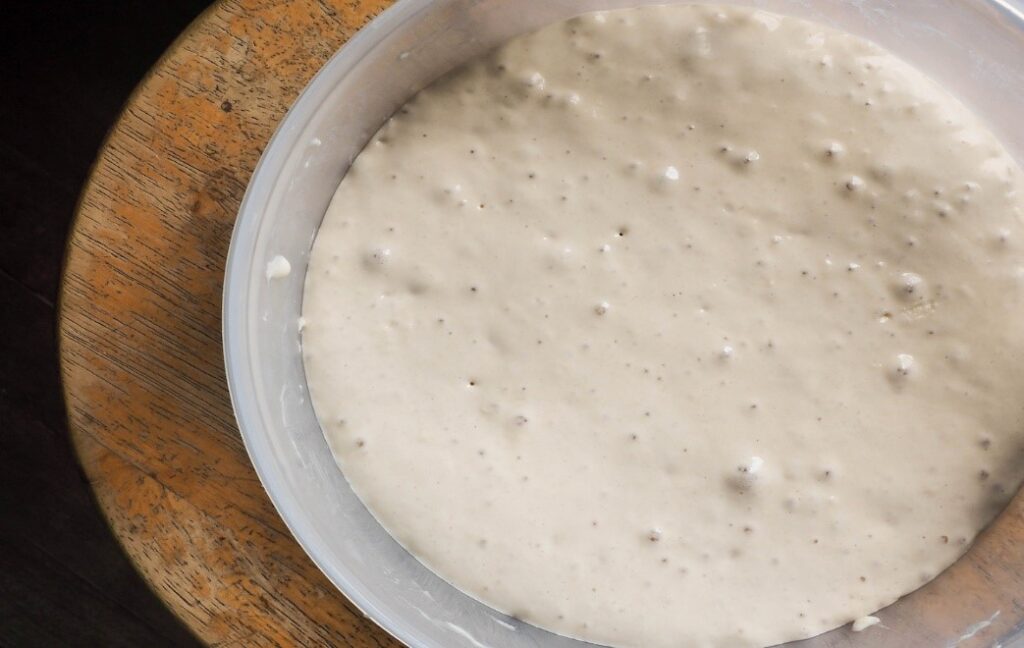Introduction
In the world of bread making, poolish holds a special place as a secret process for enhancing flavor and texture. This guide will take you into the essence of poolish.
What is Poolish
Poolish, a pre-ferment employed in the art of bread making, comprises equal proportions of flour and water, blended with a modest quantity of yeast, then allowed to ferment over a duration typically ranging from 12 to 18 hours. Often likened to a liquid iteration of sponge, poolish undergoes a fermentation process that fosters the development of intricate flavors and enhances the texture of the eventual loaf. Revered for its capacity to elevate the taste, fragrance, and general excellence of bread, poolish enjoys widespread acclaim among baking enthusiasts.
Origin of Poolish
Poolish, a pre-ferment deeply rooted in French baking heritage, embodies equal portions of flour and yeast water, allowing it to ferment over a span of 12 to 18 hours. As we delve into the nuances of poolish, it’s crucial to acknowledge other pre-ferment variations such as sponge and biga, each contributing distinctive characteristics to bread formulations.

Understanding the Preferments
Preferments, composed of flour, water, and yeast (sometimes supplemented with ingredients like salt), undergo fermentation prior to integration into bread dough. Employed in bread making, they serve to enrich flavor, texture, and longevity. Varieties such as poolish, biga, and sponge boast individual traits and historical origins. These pre-ferments contribute to gluten development within the dough, fostering improved structure and texture in the eventual baked product. Furthermore, the fermentation process within preferments yields intricate flavors and aromas, bestowing upon bread its distinctive character. In artisanal bread baking, preferments assume a pivotal role, imbuing finished loaves with depth and opulence.
Benefits of preferments and their significance:
Pre-ferments, among them poolish, bring forth a plethora of advantages to the realm of bread making. They elevate gluten formation, thereby refining texture, prolong shelf life through acid generation, and elevate flavor profiles, infusing bread with depth and flavour.
Benefits of making Poolish
- Flavor Enrichment: Poolish imparts a delightful taste and aroma, enriching the overall flavor profile of the loaf.
- Texture Enhancement: Through its fermentation process, poolish yields a soft, airy crumb complemented by a chewy crust, elevating the bread’s texture.
- Versatility: Poolish finds application across a spectrum of bread recipes, facilitating the creation of various types, from baguettes to sandwich loaves, thus enabling versatile baking.
- Professional-Caliber Outcome: Employing poolish yields bread of professional quality, characterized by a tender crumb and impeccable structure akin to artisanal bakery offerings.
The rate at which Poolish fermentation happens is influenced by following factors:
- Temperature
- Hydration
- Yeast Quantity
- Type of Yeast
- Dough Composition
- Dough Handling
- Fermentation Time
The Poolish Recipe
| Ingredient | Quantity |
| Flour | 125 g |
| Water | 125 g |
| Yeast | 0.75g to 1.5g |
Here is the end to end steps for making the poolish:
- Combine less than a gram of yeast with equal parts of flour and water.
- Thoroughly mix the ingredients until well combined.
- Let the poolish sit at room temperature for about 24 hours. Resting the dough allows time to develop flavor, structure, and texture, essential for good bread.
- Check for signs of fermentation after 24 hours, such as bubbles and increased volume.
- Once the poolish has doubled in size and appears bubbly, it’s ready to use.
- Substitute the poolish for sourdough in your bread recipe, or store it in the fridge for future use.
- Optional: Add extra yeast if desired to speed up the bread-making process.
Here is the video demonstrating step by step guide to make poolish

Conclusion:
Poolish is like a magic trick for making bread taste and feel better. It comes from France and is loved by bakers everywhere. When bakers learn about things like poolish, they can make bread taste amazing. It helps make the bread stretchy and last longer, and it adds yummy flavor. So, if you’re baking next time, try using poolish for a super tasty loaf that everyone will love.